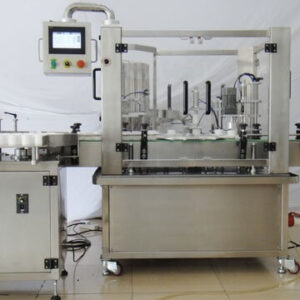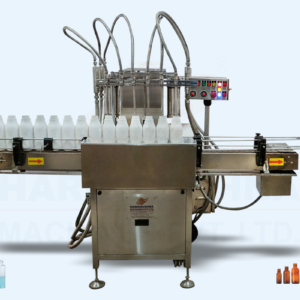Description
| Specification | Description |
|---|---|
| Machine Type | Cream Filling Machine |
| Capacity | Varies based on model; typically ranges from X to Y |
| Filling Accuracy | ± 1-2% |
| Filling Volume | Adjustable, typically ranging from A to B ml |
| Power Supply | 220V/50Hz or 110V/60Hz (customizable) |
| Power Consumption | Depends on the model; which typically ranges from C to D kW |
| Material | Stainless steel construction |
| Control System | PLC (Programmable Logic Controller) with touchscreen |
| Filling Nozzles | The number varies based on the model; typically 2 to 12 |
| Air Pressure | 0.4-0.6 MPa |
| Dimensions (LxWxH) | Varies based on model; typically E x F x G mm |
| Weight | Varies based on the model; typically H to I kg |
| Cleaning System | CIP (Clean-in-Place) system included |
| Optional Features | Ultrasonic sealing, nitrogen flushing, etc. |
- In the field of food processing and packaging that is continually evolving, cream-filling machines are instrumental in ensuring efficiency, precision, and quality in the production of different types of cream-based products. Within the recent past, these have seen considerable advancement to meet different industrial needs alongside strict hygiene and safety standards. This article explores the types, applications, purposes, advantages, and future trends of cream-filling machines, highlighting why they are essential in current manufacturing processes.
-
Types Of Cream Filling Machines
-
Piston Filling Machines
- Piston fillers are among a few popular ones used for cream filling. They use a piston mechanism to draw product from a reservoir or hopper into containers. These fillers can work with many viscosities making them suitable for creams, gels, pastes, and semi-liquid products.
-
Rotary Filling Machines
- These operate on a rotary platform where containers move along a circular path filled with cream at assigned stations. They provide high-speed filing performance meaning they can be fit for use even within large-scale production lines. They find extensive application in areas including the dairy industry as well as confectionery bakeries among others.
-
Volumetric Filling Machines
- Volumetric fillers insert an exact volume of cream per container thus ensuring consistency and accuracy during the filling process. They possess volumetric pumps or valves that accurately measure and dispense the required amount of product. Such fillers perform best when used for creams with uniform viscosity as well as density.
-
Auger Filling Machines
- This system uses an auger screw that carries the cream up into the containers being filled. The auger rotates inside a hopper picking up the product and delivering it into packaging material. These fillers serve well with thick viscous creams like chocolate spread peanut butter or cream cheese.
-
Applications Of Cream Filling Machines
-
Dairy Industry
- Cream-filling machines play an integral role in the dairy industry by helping to fill whipped creams, and sour creams other than also being used for cream cheese. They ensure accurate filling and packaging, thus maintaining product freshness as well as quality throughout the distribution chain.
-
Bakery And Confectionery
- In the bakery and confectionary sector, cream-filling machines are used to fill pastries, cakes, biscuits, and other baked products that need a creamy filling. With this machine, manufacturers can efficiently produce such goods in standard production processes to meet market demand for filled bakery products that have consistent quality and appearance.
-
Cosmetics And Personal Care
- Cream-filling machines are also used in the cosmetics and personal care industry to fill jars, tubes, and bottles with creams lotions serums, or other skin care products. These machines offer precise dosing and packaging required for delicate cosmetic formulations as well as protecting the brand’s image.
-
Pharmaceutical And Nutraceutical
- The pharmaceutical and nutraceutical industry uses cream-filling machines for filing tubes vials or containers of topical creams ointments medicated gels among others. Such machinery follows strict regulatory guidelines to ensure that there is accurate dosage while packaging has been done aseptically at all times meeting healthcare standards.
-
Functions Of Cream Filling Machines
-
Precise Dosing
- In various industries where these are used cream filing systems are designed for accurately dispensing the desired amounts of items into each container ensuring uniformity in doses thus reducing the wastage of products. This exactitude is important in preserving the quality of products throughout their lifecycle while at the same time complying with different regulations.
-
Hygienic Operation
- Hygiene in food, pharmaceutical, and cosmetic production is of utmost importance. Cream fillers are sanitary equipped such as stainless steel extensions, easy-to-clean layouts, and sterile filler chambers that prevent contaminants from accessing the filling process thus ensuring safety.
-
Versatility
- Modern cream fillers are very versatile; they can handle a wide range of cream viscosity, container size, and production volumes. Easily customizable to fit different product formulations and packaging requirements through configuration and adoption allowing manufacturing processes to be flexible.
-
Automation
- In cream-filling operations, automation helps increase efficiency and productivity. Advanced automation features like programmable controls, conveyor systems, and robotic integration in many cream fillers make the workflow easier hence saving on labor costs.
-
Advantages of Using Cream-Filling Machines
-
Increased Productivity
- Cream-filling machines enable high-speed filling and packaging which greatly increases production output than manual filling methods. This will allow manufacturers to respond effectively to an increase in demand by using more market opportunities.
-
Improved Product Quality
- By facilitating correct dosage, hygienic operation, and uniformity of filling, a machine for whipping preserves product quality Ensuring customer satisfaction thereby improving brand reputation besides minimizing product recalls or quality issues.
-
Cost Efficiency
- Though it may take a considerable initial investment to acquire a cream filler it is evident that their long-term cost-effectiveness cannot be overlooked because they reduce product wastage as well as lesser labor costs through cutting down on downtime during production this leads towards low operating expenses for the manufacturers thereby making them profitable.
-
Regulatory Compliance
- Cream fillers have been designed and engineered with regulatory standards concerning food safety, human health hygiene, and correct labeling. Practicing this principle helps producers maintain legal compliance since compliance issues can lead to hefty fines or even release from business enterprises for non-compliance with relevant agencies.
-
Future Trends In Cream Filling Technology
-
Integration Of Industry 4.0 Technologies
- The future of cream filling lies in integrating Industry 4.0 technologies such as IoT (Internet of Things), AI (Artificial Intelligence), and machine learning. Such technologies allow for predictive maintenance, real-time monitoring, and data-driven optimization of production processes to improve efficiency and performance.
-
Sustainable Packaging Solutions
- As consumer demand for sustainable packaging options continues to grow, cream-filling machines will have to accommodate eco-friendly materials and packaging formats. This includes recyclable containers, biodegradable films, and lightweight packaging solutions that reduce environmental impact while maintaining product freshness and integrity.
-
Customization And Personalization
- Consumers’ desire for personalized products is driving innovation in cream-filling technology. In the future a machine may have greater flexibility in dosing, flavoring as well as packaging customizations that will help manufacturers elicit individual preferences thus responding more effectively to market trends
-
Enhanced Hygiene And Safety Features
- In the face of increasing food safety concerns as well as health issues within pharmaceutical manufacturing; advanced features such as UV sterilization, air filtration systems, and contactless filling mechanisms are expected to be incorporated into future cream fillers so that any contamination risks are minimized while the product purity is preserved.
-
QUESTIONS AND ANSWERS
-
What is the use of cream-filling machines?
- These are devices that accurately dispense creams into containers like jars, bottles, or tubes. They are commonly used across various sectors including food processing, the bakery industry; confectionery; cosmetics; pharmaceuticals; and nutraceuticals.
-
Which types of cream-filling devices exist?
- The most popular models include piston filler units rotary fillers volumetric fillers auger fillers amongst others all with different viscosity ranges container sizes output capacities specified.
-
How does accuracy come into play concerning this equipment?
- This is achieved by designing dispensing mechanisms such as pistons volumetric pumps auger screws that permit specific dosages to be emptied into each container ensuring proper automation which includes direct communication between systems operator controls can make it better this way where needed.
-
Do they work on thick or viscous creams?
- Without a doubt, any kind of cream no matter how thick or solid can be put through any type pointed out earlier mostly those containing peanut butter similar other types known as cheese-like substances require slow pace filler so it would not clog up during operation.
-
What should be observed when using them?
- The reason for this is that they are used in industries such as food processing and cosmetics which require high cleanliness standards. These machines are made with material specifically the body part being of stainless steel mainly due to its tough nature hence not easily corroded facilitating easy cleaning as this is a major factor so that contamination does not take place within a sealed chamber.
-
Are they adaptable to particular products?
- These machines can take different shapes depending on what formulation, packaging size, and container sizes are intended for use in a given industry. For instance, companies usually have their individual preferences about how they want their products to look including whether or not there would be any changes necessary after the manufacturing process has been completed.
-
How do these machines contribute towards productivity?
- This machine makes it possible to work at an increased speed by filling up the package quickly and preventing wastage of filler materials and the product itself hence reducing labor costs. Automation is one key feature that helps streamline production workflow thereby minimizing losses while making sure only safety-approved substances go into the machinery involved thus eliminating chances of accidents happening during manufacturing operations from time to time against specified criteria.
-
Which regulations guide cream-filling equipment?
- Luxury-designed milkshake makers abide by laws set down concerning things like sanitation, labeling quality control, etc., meanwhile, manufacturers perform certain types of tests before conforming to standard requirements especially those stipulated for compliance purposes some acts certify them based upon conditions established by regulation bodies across regions worldwide.
-
Can various containers be filled using these devices?
- Yes, they can because such facilities are specifically meant for jars bottles tubes pouches trays among others thus giving rise to interchangeable head attachments and even customisation that support specific design formats available only through selected vendors who specialize in designing equipment appropriate to handling all sorts of unique shapes and configurations utilized globally today’s global village.
-
What will change in future terms?
- Some of the future trends are; the use of industry 4.0 technologies, sustainable packaging options, customization and personalization, enhanced hygiene and safety measures as well as improvements in automation and control systems. These trends are aimed at improving the efficiency, sustainability, and product quality of cream-filling operations.





